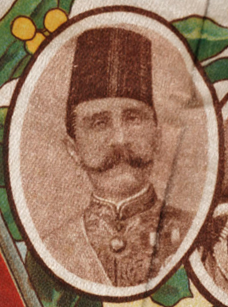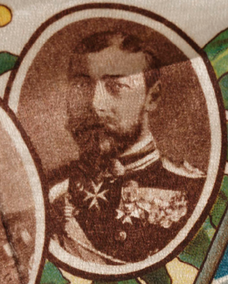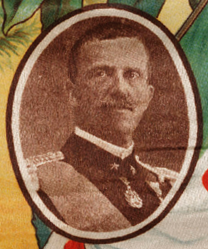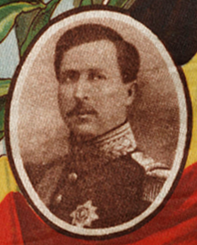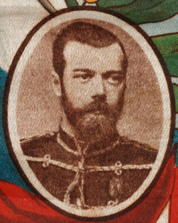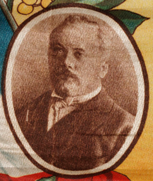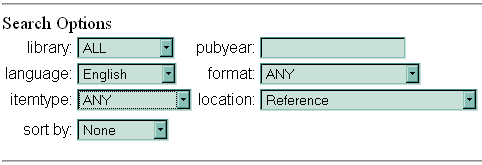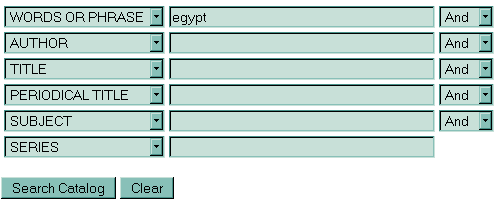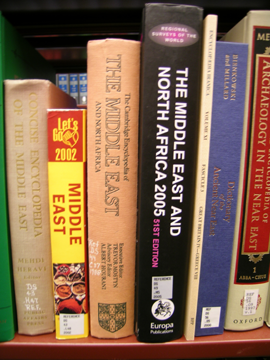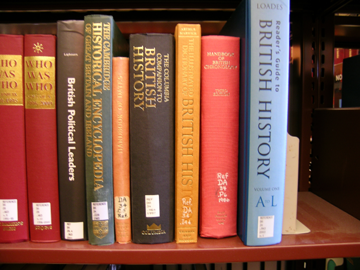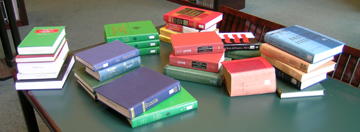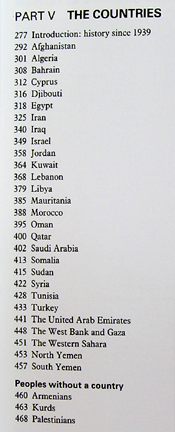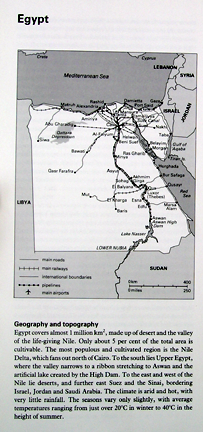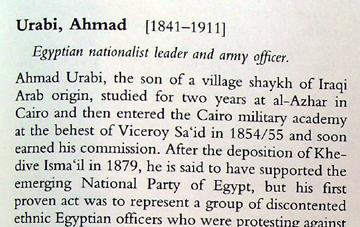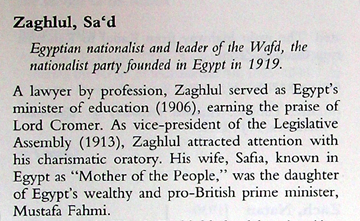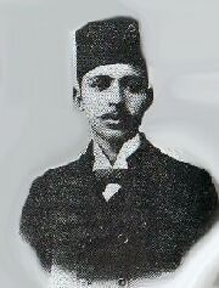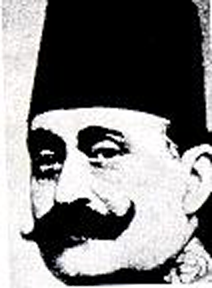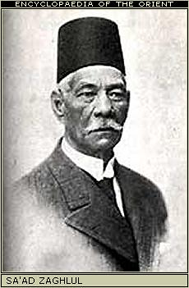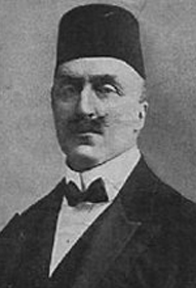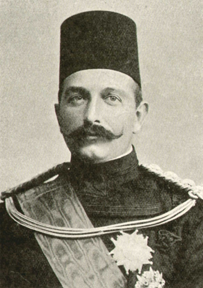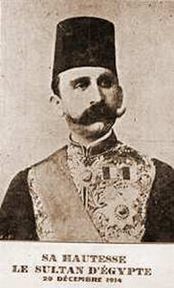The Portraits of the Souvenir of Egypt
How to Use the Reference Section
If there is one area in the library in which one feels that a huge amount of
information is within arm's reach, it is the Reference section. Here we will show you
exactly what we mean by looking up a few works that should
provide us with some useful information about the possible identities of the men
in our portraits and then browsing the surrounding shelves for more.
Targeting a Resource in Reference
The library's Reference section offers a number of useful tools for quickly finding basic facts
and getting started with research projects. For instance, Reference contains encyclopedias,
atlases, dictionaries, manuals, guides, collections of brief articles, and more. Since
everything is arranged by call number, once you find one or two relevant works, you will likely
find more close by on the shelves.
Let's begin by searching the catalog for works on Egypt. For purposes of demonstration, we'll
use Fondren library's online catalog WebCat,
but a similar process will work at most other libraries.
(If you want to learn more about using library catalogs, please visit our WebCat Module).
Our first step is to make sure that our search is limited to
the Reference section. Look to the bottom of the Advanced Search page and
you will see a series of text boxes. Location the one labeled location and
highlight reference. It should look like this:
Then we need to specify what type of reference material we need. We
will be searching by region. In the previous module on identifying the flags present in the
Souvenir of Egypt, we learned that one of the most prominent flags was the Egyptian flag between 1914 and
1923. Of course, "Egypt" is also printed on the silk, so let's start our search for reference
tools that
country.
.
Our results have a variety of call numbers, but notice the similarity
in those that seem most promising.
It looks like DT in the 40's and 50's is our area. Through a similar process, we find
that
Britain is in DA around the 20's
Italy in the DG 450's
Russia in the DK30's
And France in the DC30's. They sound as if they are all within arm's
length of each other. Let's have a look on the shelves.
Our book on Egypt is not on the shelf. However just to the left we find
in the DS section shelves and shelves of books on the Middle East and just to
the right as many shelves on Africa, both of which should contain reference
material on Egypt.
Britain is well represented.
As well as France. Nearly all of the works we need are within five feet of
one another. In browsing between the sections we come across what would appear to
be an invaluable resource for our project, Rules and Governments of the World.
We need a
a comprehensive list of
the leaders of the world and the dates they held
their positions, so this book seems to be perfect. Let's gather up the most promising
works and get to work.
What do we know about this image from our research so far? The portrait
sits beside what used to be the national flag of Egypt, originally the
personal standard of Muhammad Ali, who led Egypt in the nineteenth century. We
also know that the flag was officially in use there as a national flag from 1914
until 1923. Let's begin our search by finding out who was who in Egypt during
that period and the surrounding years and see about locating any images of those
figures there might be available. Considering the lack of specific reference
material on Egypt during our period, let's cast a broader net and find Egypt in
the context of the Modern Islamic World, our first regional encyclopedia.
Regional Encyclopedia
A regional encyclopedia contains a variety of
statistical and historical information about a specific region of the world. It
is usually categorized by subject or section of the region and is comprised of
entries listed alphabetically within related subject sections. These books differ in their
level of detail. For example, The Oxford Encyclopedia of the Modern Islamic World
offers general information about Egypt, but lacks a listing of the country's leaders in the
early twentieth century. Rather, the book focuses more broadly on many regions within the
Islamic world over some 1500 years. For our purposes, this listing is lacking; there is no listing of
Egypt's leadership during our period. This is probably because the Islamic World
consists of many regions over some fifteen hundred years.
Let's get more
specific.
The Cambridge Encyclopedia of the Middle East and North Africa
is an encyclopedia limited to the region of the
Islamic World known as the Middle East.The table of contents reveals the diversity of the entries in the work
from cultural subjects to countries.
Let's locate Egypt.
The entry provides some historical information related to our
project: “"The French invasion of Egypt under Napoleon Bonaparte and the short
occupation (1798-1801) which followed exposed Egypt to Western ideas and technology (see
Modern History). French withdrawal was followed by the foundation of a new dynasty under
Muhammad 'Ali, an officer from Kavala in Macedonia who led Albanian soldiers to Egypt in the
nominal service of the Ottomans. Muhammad 'Ali held power from 1805 until his death in 1849,
establishing virtual independence from Istanbul and initiating a process of modernization
which reached its peak during the period of rule of his grandson, Khedive Isma'il. A
negative legacy of Muhammad 'Ali's successors, Sa'id and Isma'il, was to saddle Egypt with an
unmanageable foreign debt. The debt led to assumption by Britain and France during the last
quarter of the nineteenth century of a large degree of control over the economy. Isma'il was
forced to abdicate in 1879; in 1882 British forces invaded Egypt to suppress a movement of
opposition to the Khedive's rule and the growth of foreign control, led by an army officers,
Ahmad 'Urabi. In one form or another British control continued until 1936, when an
Anglo-Egyptian Treaty gave Egypt a limited independence. Full independence was only secured
after the last of the dynasty founded by Muhammad 'Ali, King Faruq, was overthrown by the
nationalist 'Free Officers' Movement.'"” We have a few names that may be our man, Ahmad ‘Urabi and King Faruq.
The others seem before our period. Let's try another encyclopedia.
The Encyclopedia of the Modern Middle East covers the same region, but may provide
different results since it is focused on a specific period.And indeed, we have a few more potential matches: “
"Britain took virtual control of Egypt's finances and foreign affairs, and the real ruler was
Britain's consul general. In response, a national movement emerged with the objective of
achieving Egypt's independence. The struggle of Mustafa KAMIL, Muhammad FARID, and Sa'd
ZAGHLUL achieved 1922. On 28 February, Britain's declaration terminated the
protectorate (declared in October 1914), proclaimed Egypt a sovereign, independent kingdom, and
reserved four issues for future negotiations: imperial communication, defense, minorities, and
the Sudan. On 15 March 1922, Ahmad FU'AD was proclaimed king; a constitution was issued on 9
April 1923."
”
Mustafa Kamil, Muhammad Farid, Sa’d Zaghlul and Amhad Fu’ad. Let's try
a political dictionary we found.
Political Dictionary
A political dictionary offers an alphabetical
listing of a variety of terms including proper names and the names of
events related to the political history of a region. It is an invaluable
resource for one researching a region of the world with which they are
unfamiliar.
Our political dictionary focuses on the region at hand during the period we
are focusing on: Political
Dictionary of the
Middle East in the 20th Century . Under the listing for Egypt we find a few more candidates: “"On the eve of
World War I, E. was, in international law, part of the Ottoman Empire, but actually ruled by
the British. On 18 Dec. 1914, one month after war had been declared, Britain severed the
formal link between E. and the Ottoman Empire and declared E. a British Protectorate. E. was
promised that Britain would guide her toward self-rule and that the capitulationist would be
abrogated at the end of the war. At the same time the British deposed the Khedive 'Abbas
Hilmi and replaced him with his uncle, Hussein Kamel, giving him the title of Sultan (he died
in 1917 and was succeeded by his brother, Ahmad Fu'ad.)”‘Abbas Hilmi and Hussein Kamel.
Our regional encyclopedias and dictionaries are also good for
identifying the role individuals played in its history, as you can see.
But we are provided with no pictures. At this point we have gathered
enough information to move on to the next resource; we have names, but still no
faces to match them to.
Hunting for the face with the name
Looking for an image, whether a
photograph or a sketch or anything really, there is one online resource that is
tough to beat: the Google image database. When
you get to the homepage, just enter the full name of the person you would like
to see an image of and Google will search through millions of images for a
match.
Let's try a few of our names to see what faces come up. If you
would like to take a look at our portrait for comparison click here, Face 1. Our
search produces the following images for the names we've identified:
Mustafa Kamil at MUZonline
Mohammad Farid at SIS, the Egyptian
State Information Service,
Sa'd Zaghlul at Al-Ahram
Amhad Fu’ad at genealogia
'Abbas Hilmi at FirstWorldWar.com
and Hussein Kamel at l'Egypte
d'Antan.
It would seem that the mustachioed fez look was a popular one
in early twentieth-century Egypt, but it also seems clear that Hussein Kamel's portrait
comes the closest to our man. When we look to the details it is further
confirmed. Notice the similarities in dress, particularly the sash, large button
and medal combination in both images. It appears that we have identified the
first face as Hussein Kamel, who we quickly discover in our encyclopedias was the
Sultan of Egypt from 1914 until 1917.




